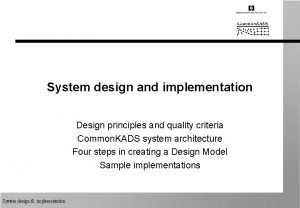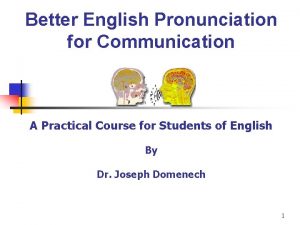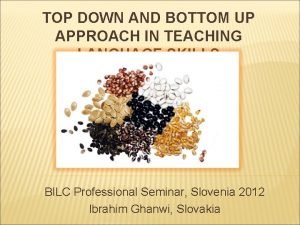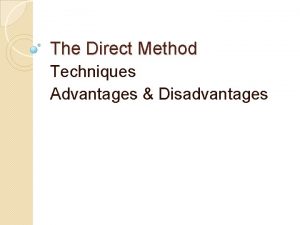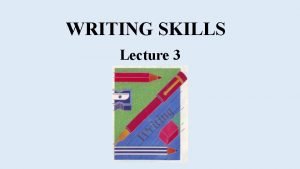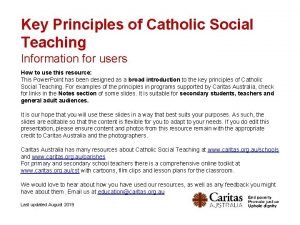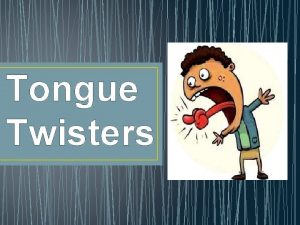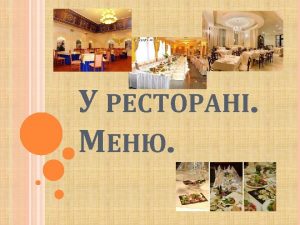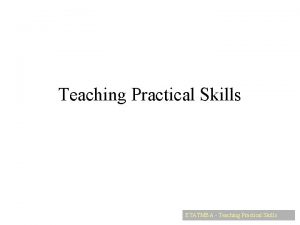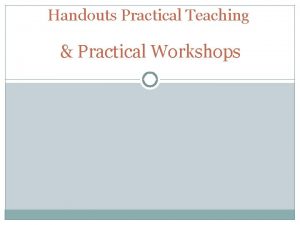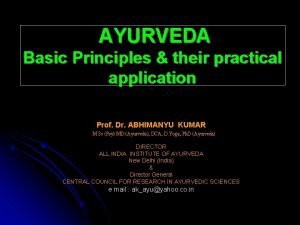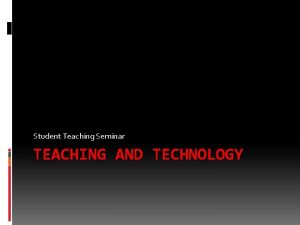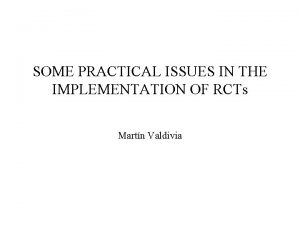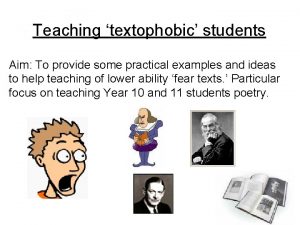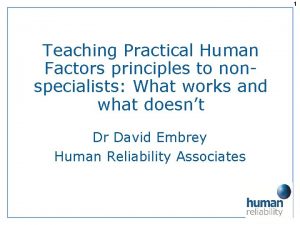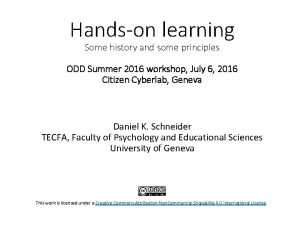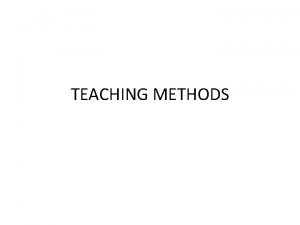Teaching English Some practical principles and their implementation















































- Slides: 47

Teaching English Some practical principles and their implementation 1

Practice and underlying principles “Give a hungry person a fish and you feed them for a day. Teach them to fish, and you feed them for a lifetime. ” But Knowing how to fish won’t help them if they’ve starved to death today because you didn’t give them a fish. 2

You need both Teachers usually ask for practical ideas. Limiting. Researchers want to give theory. Not much use without practice. This session: practical principles + illustrations in practice 3

The first year 4

The central issue: repetition 5

One-off learning doesn’t work Any bit of language you teach will need to be repeated, revised, practiced … We have to find ways of doing this which aren’t boring. 6

The main problem: Keeping students on task 7

Given there’s a lot of repetition What kinds of things can we do to maintain student engagement? 8

Practical Principle #1: Keep them actively busy 9

Teacher questioning 1. What is a one-word verb that means the same as go into? 2. Is foreign an adjective or a noun? 3. What is the opposite of day? 4. What is another word for small? 5. A dog is a kind of …. what? 10

‘IRF’ … is the most common kind of classroom interaction. It is also the most boring … and least productive of learning Most of the students are inactive most of the time. 11

Another problem There’s only one, short, right answer. As soon as one student has answered right – nobody else can. Let’s try a variation… 12

1. Use questions with lots of possible right answers 1. Another word for go into is enter. What kinds of things can you enter? 2. Foreign means ‘of another country or people’. What kinds of things can be foreign? 3. The opposite of day is night? Can you think of other opposites? 4. Another word for small is little? Can you think of other pairs of words that mean the same as each other? 5. A dog is a kind of animal. Red is a kind of color. Can you think of other similar pairs …? 13

More students are busy The questions were open-ended: lots of right answers. I can still answer something new even after another student has answered. I have to listen … More student participation for each item 14

But still: only one student speaks at a time … and the rest are inactive. 15

2. Raise the speed: do without ‘nomination’ Let students call out answers as they occur to them. Day is the opposite of night. What other pairs of opposites can you think of? 16

Students call out answers as they think of them … you repeat or write up as you hear them. You may not hear a student’s contribution first time. So they’ll need to say it again. Good. 17

3. Writing answers on the board Two or three students at a time. Any student who finishes hands the marker to someone else. small means the same as little. Can you think of more pairs of words like this? 18

4. Pair or small-group work 1. What area in the world does the word tomato come from? 2. Are there more native or non-native speakers of English? 3. What is the most common word in the English language? 4. Name two countries where English is an official language, but most people have other native languages. 5. Can you give at least one other word for ‘red’ in English? 19

Answers 1. 2. 3. 4. 5. Central America Non-native the India, Nigeria, Singapore … Crimson, vermilion, scarlet … 20

5. Pass it on You can work alone or with a friend. Take a clean piece of paper; Choose any number between 1 and 6. 21

5. Pass it on Write the heading you chose at the top of your paper. Write the first line of the poem, and pass it on. 1. Winter is here 2. An apple tree 3. My family 4. She’s asleep 5. A noisy street 6. Chocolate 22

Pass it on: Variations Do as much as you can of an exercise until the teacher says stop, then pass it on Write another sentence in a story, pass it on Write all the associations you can think of for a given word, pass it on 23

6. Worksheets Photocopied, or on the board. A variety of tasks, in sections. An optional section. Tip: Invite them to start wherever they like. 24

Worksheet items 25

A variety of tasks • • • • True/false; Match /link Underline Multiple-choice: circle the right answer / delete the wrong ones Gap-fill (with or without a ‘bank’ to choose from) Complete the sentence (any way you like) Copy the right answer(s) Write the right answer(s) Classify into groups Prioritize in order of… Identify the odd one out Draw… Write down as many … as you can 26

Practical Principle #2: Successorientation 27

Plan tasks so the students are likely to succeed … And then praise them for doing so. 28

Too easy rather than too hard If you’re not sure: choose the easier option. (Add an optional extra? ) 29

Spend time on instructions Slowly, clearly Repeat Write as well as say Ask a student to explain in L 1 30

Set an achievable goal: Make it clear you don’t expect them to do it all / get it all right ‘Do as much as you can’ ‘Do at least … items’ ‘Do as much as you can in five minutes’ ‘Do as much as you can before I say stop’ 31

Copy all the items into the right columns a clock, a dog, a dress, a mother, black, a pen, bread, pants, bag, a husband, red, boots, a cat, rice, a frog, a baby, pink, a teenager, a hat, a banana, a book, a sheep, meat, kids, a desk, green, an elephant, salt, a t-shirt, white animals colours things food clothes people 32

Find at least three things to put in each column a clock, a dog, a dress, a mother, black, a pen, bread, pants, bag, a husband, red, boots, a cat, rice, a frog, a baby, pink, a teenager, a hat, a banana, a book, a sheep, meat, kids, a desk, green, an elephant, salt, a t-shirt, white animals colours things food clothes people 33

Do frequent ‘tests’, but make sure they ‘pass’ Tell them exactly what’s going to be on the test Review the test material in advance Do ‘rehearsals’ of the test format Help weaker students during the test. 34

Think of easier variations to conventional tasks Harder: Write down / say words beginning with D Easier: Write down / say all the words you can think of that have D in them Harder: Give me a sentence with the word hard Easier: Tell me all the things you can think of that are hard. 35

Practical Principle #3: Maintain personal relationships with students 36

Learn their names … as quickly as you can. Spend time testing yourself: ‘You are …, right? ’ Time well invested. 37

Find out about them Where they live Pets Names of brothers and sisters Favorite … (color? animal? sport? TV program? Food? ) Note and remember answers! Demonstrate you remember! 38

Tell them about yourself Name Family Where you come from Favorite … Things you don’t like … Anything special Invite them to ask you questions about yourself (reserving the right not to answer!) 39

Practical Principle #4: Talk a lot 40

You may have been told: minimize Teacher Talk Time ‘TTT’ is a bad thing Nonsense. ‘Teacher Talk Time’ is a good thing: For many, it’s their only exposure to personally addressed English talk 41

PROVIDED it is understandable It is interesting 42

So Keep to simple words Speak slowly Repeat Talk about things that will interest them Stories? 43

Reinforce with body language: Facial expression Gesture Movement 44

Practical Principle #5: Plan ahead 45

Write out your lesson plans Varied, short components More rather than less Make sure you have a reserve Share with students Recap at the end 46

Thank you for your attention pennyur@gmail. com 47
 Direct method teaching
Direct method teaching Principles of direct method of teaching english
Principles of direct method of teaching english Contact force
Contact force Some trust in chariots and some in horses song
Some trust in chariots and some in horses song Scaled down teaching meaning
Scaled down teaching meaning Implementation design principles
Implementation design principles They say sometimes you win some
They say sometimes you win some Sometimes you win some sometimes you lose some
Sometimes you win some sometimes you lose some Ice cream is countable or uncountable
Ice cream is countable or uncountable Some say the world will end in fire some say in ice
Some say the world will end in fire some say in ice Some say the world will end in fire some say in ice
Some say the world will end in fire some say in ice A practical course in english pronunciation
A practical course in english pronunciation Desuggestopedia principles
Desuggestopedia principles End goals of mtb-mle
End goals of mtb-mle Expository and exploratory approach
Expository and exploratory approach Top down in reading
Top down in reading What are the disadvantage of direct method
What are the disadvantage of direct method Section 1 organisms and their relationships
Section 1 organisms and their relationships Principles of ecology organisms and their relationships
Principles of ecology organisms and their relationships Prolog romeo and juliet
Prolog romeo and juliet English literary periods
English literary periods Principles for teaching writing
Principles for teaching writing 7 principles of teaching
7 principles of teaching Definition of remedial teaching
Definition of remedial teaching Catholic social teachings
Catholic social teachings The principles of interactive language teaching
The principles of interactive language teaching What are the objectives of micro teaching?
What are the objectives of micro teaching? Principles of micro teaching
Principles of micro teaching Principles of cst
Principles of cst 10 principles of effective online teaching
10 principles of effective online teaching Principles of interactive language teaching
Principles of interactive language teaching Funny tongue twisters for adults
Funny tongue twisters for adults Betty botter tongue twister
Betty botter tongue twister Teachingenglish.org.uk
Teachingenglish.org.uk Innovative methods of teaching english language
Innovative methods of teaching english language Language
Language Principles of bilingual method
Principles of bilingual method Mandeep kang
Mandeep kang Shira packer
Shira packer Micro teaching lesson plan for english
Micro teaching lesson plan for english Macam macam evaluasi
Macam macam evaluasi Lesson plan micro teaching
Lesson plan micro teaching Teaching young learners english
Teaching young learners english Substitution tables for teaching english
Substitution tables for teaching english Backward build up drill
Backward build up drill Teaching english with technology
Teaching english with technology Substitution tables for teaching english
Substitution tables for teaching english Tagxedo
Tagxedo





